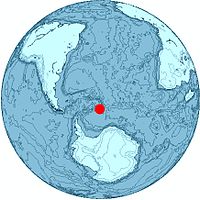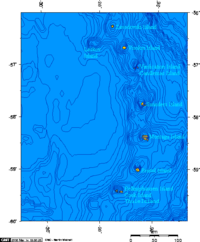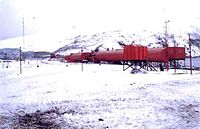Southern Thule

Coordinates: 59°25′16″S 27°13′49″W / 59.42115°S 27.23041°W

Southern Thule is a collection of the three southernmost islands in the South Sandwich Islands:
Southern Thule is part of the British overseas territory of South Georgia and the South Sandwich Islands. The islands are barren, windswept, bitterly cold, and uninhabited. They have however an extensive Exclusive Economic Zone rich in marine living resources managed as part of the SGSSI fisheries.
The Admiralty's Antarctic Pilot says that Southern Thule is part of an old sunken volcano, and is covered with ash and penguin guano. There are seals, petrels, and a bank of kelp just offshore, especially around a small inlet on Thule Island called Ferguson Bay.
The island group was first sighted by in 1775 by the expedition of James Cook, who named it Southern Thule because it seemed to lie at very much the extreme end of the world just as the legendary Ultima Thule marked the northern limit of the world for the ancients. It was further explored in 1820 by Fabian Gottlieb von Bellingshausen, who established that it consisted of three separate islands.
Argentine occupation 1976–82

In November 1976, a party from the Argentine Air Force landed on Thule, and, without informing the British Government, constructed a small military base complete with barracks and a small concrete helicopter landing pad. They set up a weather station, a radio station, and a flagpole from which the Argentine flag flew. All this was done at the direction of the Argentine Government in order to back up their territorial claim to the South Sandwich Islands. The base was named Corbeta Uruguay.
It was not until December 1976 that the British discovered what had happened. The Argentine action became the subject of a number of official British protests, the first of them on 19 January 1977. In November 1977, under the name Operation Journeyman, then Prime Minister James Callaghan sent a naval taskforce consisting of the nuclear-powered submarine HMS Dreadnought, two frigates, and two support vessels, in order to deter any threat to the Falklands, but ruled out using direct force to end the occupation of Southern Thule.[1][2]
Arrangements to legitimise the station were discussed in 1978 but failed. More than a year went by before word of the occupation of Southern Thule leaked out to the public. The then Prime Minister, James Callaghan, ruled out sending in the Royal Marines to end the occupation, preferring diplomacy. This unwillingness to project force, plus the British Government's intention to cut back the British military presence in the Antarctic for financial reasons, led the Argentine Government to believe that they could successfully occupy and annex the Falkland Islands and South Georgia, which they attempted in April 1982, sparking the Falklands War.
The Argentine presence remained on Southern Thule until six days after the Falklands War had ended. On 20 June 1982, several British warships landed Royal Marines and the Argentine garrison, outnumbered and outgunned, surrendered and handed over their weapons.
Aftermath
After the surrender, Southern Thule was left deserted, but six months later, a passing British warship noticed that the Union Flag had been taken down from the flagpole at the deserted base and the flag of Argentina run up in its place. When word of this reached London, the military was ordered to destroy all buildings on Southern Thule, leaving Corbeta Uruguay unfit for prolonged habitation. By Christmas 1982, the barrack block, mess room, and meteorological station were reduced to a pile of concrete rubble, leaving only a small hut stocked with emergency supplies and the flagpole, which was last seen flying the Union Flag.
References
- ↑ Ben Fenton (1 June 2005) "Secret Falklands task force revealed", Daily Telegraph
- ↑ BBC News: Secret Falklands fleet revealed
Books
- Simon Winchester, Outposts: Journeys to the Surviving Relics of the British Empire, Harper Perennial, 2004 (originally published in 1987).
| South Georgia and the South Sandwich Islands | |
|---|---|
| South Georgia: | Annenkov Island • Bird Island • Clerke Rocks • Cooper Island • Grass Island • Kupriyanov Islands • Pickersgill Islands • Saddle Island • Shag Rocks • South Georgia • Welcome Islands • Willis Islands • Trinity Island • Grassholm • Black Rocks • Black Rock |
| South Sandwich Islands: |
Bellingshausen • Bristol • Candlemas • Cook • Leskov • Montagu • Saunders • Thule • Vindication • Visokoi • Zavodovski |